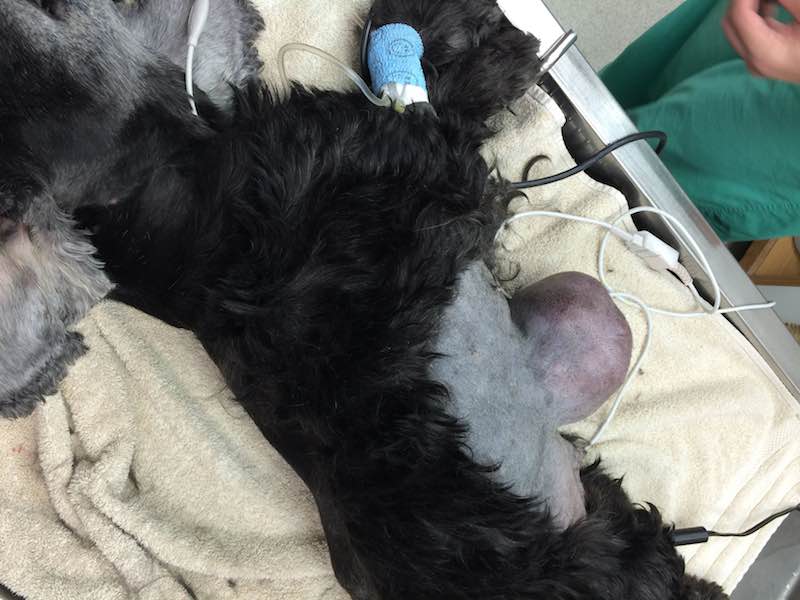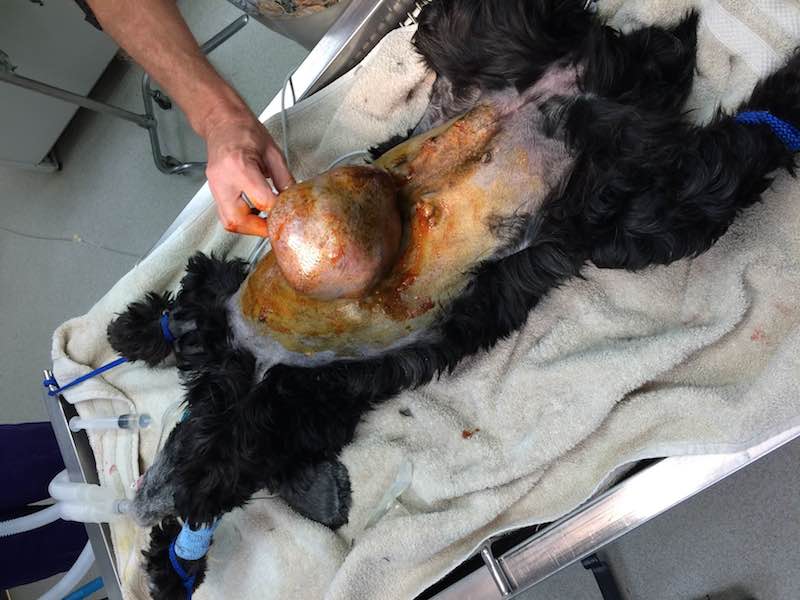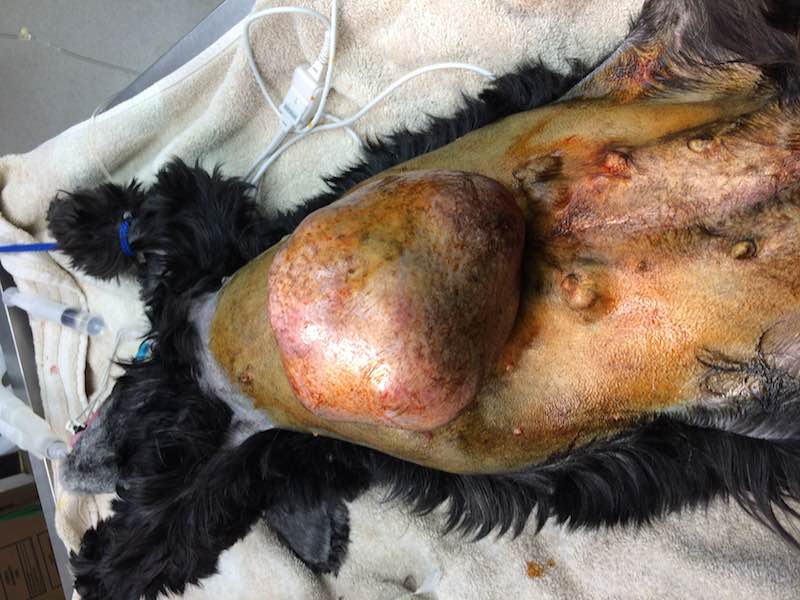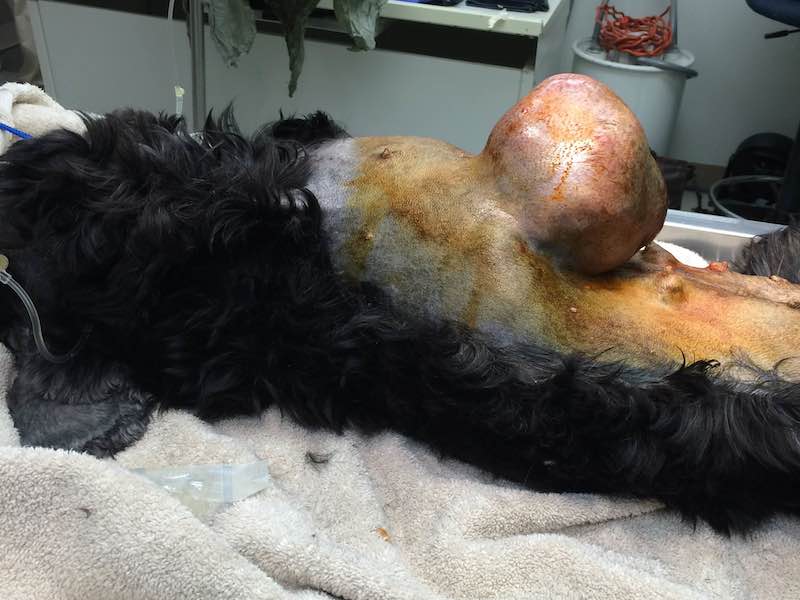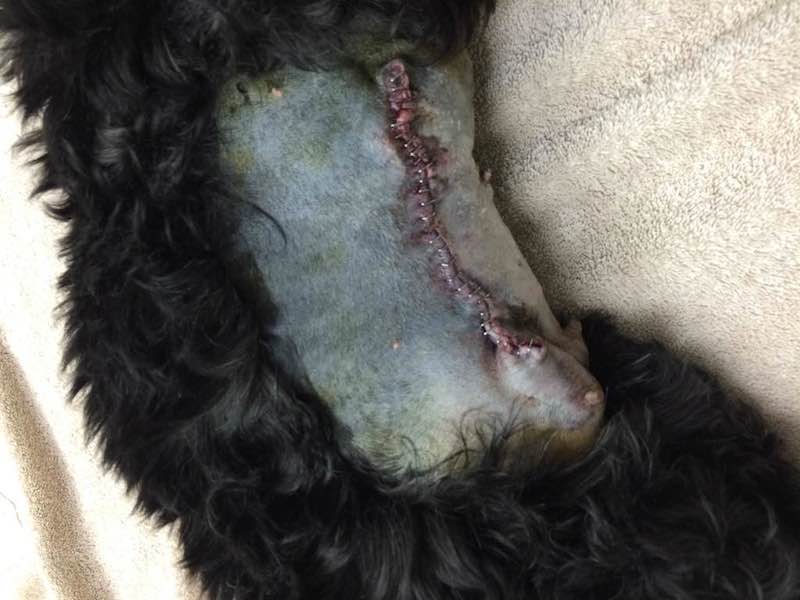Case Studies
BOOK APPOINTMENTLocation
2145 W Park Blvd
Plano, TX 75075
We are on the North West Corner of Park & Custer (Behind the Walgreens)
Hours
Mon - Thurs: 8:00am - 5:00pm
Closed 1:00pm - 2:30pm
Fri: 8:00am - 12:00pm
Sat-Sun: Closed
Pet Allergies Case Studies
Case #1
Many owners mistakenly believe that the source of their pets’ allergies is food allergies. While food allergies can occur in pets, they are very rare. I’ve only seen 1 proven case of food allergy dermatitis in over 20 years of practice. Having said that, there is no question that eating poor quality food does contribute to a whole host of medical problems for people and their pets. This is one of the reasons I always try to correct the diet of any pet that is being treated with integrative medicine, and is the reason that feeding the proper diet is the #1 step in my holistic healing program regardless of the pet’s current health status. Without feeding the pet a proper diet, devoid of potentially harmful animal and plant by-products and chemical preservatives and flavorings, my therapies won’t achieve their maximum effectiveness. Feeding the proper diet is the foundation of every integrative therapy regardless of the disease afflicting the pet. While I always support owners who choose to prepare food for their pets at home, feeding it either cooked or is a raw diet, the reality is that most owners find it more convenient to feed a prepared food. While there are many different brands of prepared foods on the market, I believe that most are worthless. They contain way too many chemicals and animal and plant by-products which contribute to disease. Examples of some diets I currently recommend to my patients include Nature’s Variety, Eagle Pack, Wysong, Innova, California Naturals, Natural Balance, Blue Buffalo, and Life’s Abundance.
Instead, allergies in pets are usually due to environmental allergens. Most pets (and their allergic owners) have allergies to multiple allergens, including house dust mites, Bermuda grass, St. Augustine grass, fleas, cat dander, ragweed, and various other trees and plants. Allergy testing, done by veterinary dermatologists who inject small amounts of allergens within the skin and observe the pet’s reactions, are necessary to diagnose exactly which allergens affect the pet if the owner or doctor wants to treat the pet with frequent “allergy shots.” Since most of my clients, including Shelly, do NOT want to give their pets shots for life, they seek my help in designing a natural protocol for their pets.
Regardless of whether using a conventional or integrative approach, I always start with a good history and physical examination. It’s possible the history and physical exam will assist in making the diagnosis (in the case of pets with allergies, usually the diagnosis is made just from these 2 steps.) Often other problems related to the allergies, such as an ear or skin infection, will also be discovered. Additionally, many times when I examine a pet for a specific problem, I will find something totally unrelated such as heart disease or dental disease. Since the integrative approach focuses on the patient and not the disease, it’s really important to identify other problems that may coexist with the owner’s original complaint. Sometimes, these additional problems may be even more important or detrimental to the pet’s health than the original complaint and must be addressed as well.
Fortunately, Brit had no other problems that I discovered or that Shelly mentioned during the initial visit.
During my examination, I noticed that Brit’s skin looked pretty normal, except for a few areas of irritation. These irritated areas were reddened and bore scratch marks as a sign of her scratching her itchy skin. It’s not unusual for itchy pets to have essentially normal skin. One of the ways that I determine that the cause of itching is due to allergies rather than something else is the appearance of “normal skin in an itchy dog.” Occasionally, I’ll actually see skin lesions on an allergic pet. These lesions, which can be pustules (pimples,) papules (tiny red bumps,) or scabs or crusts, represent a secondary infection with bacteria or yeasts. Since allergic skin is not normal, secondary infections occur more easily in allergic pets. I would estimate that about 50% of the allergic pets I see have a secondary infection. These infections by themselves can be very itchy, and they must be treated correctly in order to reduce the pet’s level of itching. If the infections are not properly diagnosed and treated, the pet will never get better.
Conversely, a common cause of repeated and chronic skin infections is allergic dermatitis (food sensitivity and thyroid disease also predispose a pet to skin infections.) Unless the pet’s underlying allergies or other problems are discovered, the pet will continue to suffer from chronic infections.
Since Brit didn’t have any obvious skin infections at this first visit, this meant my only concern would be to address her allergies. Each patient is an individual and is to be treated as such. No 2 cases are exactly alike and there is often no one way to deal with a certain medical problem. This is why it’s impossible for me to accurately answer a question owners often pose to me, “How would you treat my pet with (name of the disease)?” I have no idea how I would treat such a pet until I see the pet and thoroughly review the case!
The holistic approach, in my opinion, is often more art than science (although we have a lot of science to back up our chosen therapies.) This means that the holistic doctor must take time to properly evaluate each case. The pet owner is a partner in the diagnosis, treatment, and healing of the pet. Ultimately our goal is to heal the pet, rather than treat a disease (a very different approach than the one I had learned in my conventional medical career.) Healing is a lifelong process, whereas simply helping the pet feel better and treating a disease lasts only a short period of time.
I chose to treat Brit with several natural therapies that I have worked well for most of my patients. As is true with the goal of healing that all holistic doctors have for their patients, there is no one therapy that is best for each case. In fact, multiple therapies are usually chosen to heal the patient. Using multiple therapies has an additive effect that better and more quickly promotes healing. So in addition to her acupuncture treatments, I prescribed several other therapies to help Brit heal from her recent allergy attack.
First, regular bathing with an organic based shampoo helps relieve itching and inflammation, and removes surface bacteria and yeasts. Regular, even daily bathing is needed to allow healing and reduce the need for conventional medications like steroids. I prescribed Dr. Shawn’s Itch Relief Shampoo to be used as often as needed.
Second, anti-inflammatory herbs can act as a natural steroid to help relieve itching and inflammation. I prescribed Xiao herbal drops to be given twice daily.
I also find that immune support is helpful for pets with allergies, so I prescribed twice daily dosing with Dr. Shawn’s All Natural Olive Leaf Plus. This product also is useful as a drug replacement for my patients with bacterial and yeasts infections, especially of the skin and ears.
Oral fatty acids, particularly high doses of quality fish oil, are helpful to not only reduce itching but actually change cell structure to provide long term health benefits. Brit began taking high doses of EPA and DHA found in my fish oil supplement.
Finally, a natural antioxidant is useful for pets with skin diseases. I prescribed Total Anti-Inflam, a powerful combination antioxidant, to help Brit’s skin disease.
Thankfully, this natural approach has worked well for Brit as it has for thousands of my patients. Using this approach allowed us to treat Brit without the need for medications. While some patients using this natural approach do require infrequent, very low doses of medications to quickly quelch their itching, Brit was able to heal without any medication!
Case #2
This is an actual before and after photo of a young golden retriever who came into our animal hospital suffering from “allergies and infection” most of its life. The typical veterinary treatment of steroids and antibiotics failed to provide a long-lasting cure.
As I explained to the owner, we must ask the question…Why? Why does this dog have this problem (it’s not because, as prior doctors had told her, that retrievers all have bad skin!) We tested the dog for several problems including thyroid and adrenal disease and immune dysfunction, as well as MRSA. Fortunately, the testing did not show any major problems and I treated the dog with several of my herbal remedies. To date, the dog is doing great and has not had any more unnecessary antibiotics or steroids.
Breast Cancer Case Studies
Case #1
These pictures are of a large breast tumor in a 14-year-old cocker spaniel named Onyx. Her owners drove from Houston to our Paws & Claws Animal Hospital since they wanted a safer approach to anesthesia and a more natural approach to treatment. We removed a large 2 pound tumor and then put her on our unique protocol of natural herbs and homeopathics for cancer. This protocol uses various herbs, homeopathics, and nutritional supplements (some of which we have designed for our patients!) that have been shown to help many of our patients live 6-12 months longer than expected if the pet was not treated with these specific therapies. The pets we help are those who are treated with conventional therapies, often including chemotherapy and radiation (based on reported studies patients using these conventional therapies often have fewer side effects and the conventional therapies work better to kill cancer.) However, many of our patients do NOT receive chemotherapy or radiation but still respond nicely to our therapies which support the immune system, enhance detoxification, and support damaged organs.
We have many clients who seek our more natural approach to cancer using natural medicines for organ support, immune system support, and detoxification. All of these unique therapies are designed to help the pet feel much better, reduce cancer growth and spread, and reduce the chance for recurrence.
- Before surgery. Onyx safely under anesthesia and showing her tumor.
- Before surgery. Onyx safely under anesthesia and showing her tumor.
- Before surgery. Onyx safely under anesthesia and showing her tumor.
- Before surgery. Onyx safely under anesthesia and showing her tumor.
- Carefully removing her tumor.
- Tumor after removal.
- Post surgery. Onyx recovering well.
- Post surgery. Onyx recovering well.
Cancer Case Studies
Of all of the cases we treat using integrative medicine, none are more rewarding than our patients battling cancer. Most pets with cancer are given a prognosis of another 6-12 months of life by conventional veterinarians. My practice is different:in most cases, these special pets live an additional 6-12 months longer than expected simply by using natural therapies (many cases live over 12 months longer, some live 12-24 months longer, and a few are actually cured of cancers deemed “incurable” by conventional medicine.) This is the reason other veterinarians, even cancer specialists, refer cases for our help.
I’m often asked, “Dr. Shawn, how do you treat cancer and get such wonderful results?” The answer is that I DON’T TREAT CANCER….I treat PETS who have cancer.
I believe that is an importance difference: by focusing on the pet,
and not just the cancer, we often get better than expected results.
Think about this-cancer develops for a specific reason. If we do surgery to cut it out, chemotherapy to poison it out, and radiation to burn it out, but we don’t address the reason the pet got the cancer (a poor immune system,) why are we surprised when the cancer quickly returns?! We shouldn’t be surprised because all we’ve done is treat the cancer but ignored the reason for the cancer. If we fail to address the pet’s immune system (“why” it got cancer,) then we’ve changed nothing and the pet is set to get more cancer (and since chemotherapy and radiation both have “more cancer” as side effects from the treatment, you can see why supporting the pet’s immune system is so important, especially if these strong therapies are utilized.)
Note: Now we have simple and inexpensive blood testing that helps us diagnose cancer early, before the pet becomes sick with its cancer. These blood tests also reveal high levels of inflammation and low levels of vitamin D, both something that predispose pets to many chronic diseases, especially cancer.
Pets, and their cancers, are unique. No 2 cancers are genetically identical. While results vary with each case, and no guarantees can ever be made, the following 3 cases are representative of our typical cancer patients.
Case #1
Shrek had been misdiagnosed as having hip dysplasia and arthritis as the cause of his rear-legged lameness when his owner sought my help several months following his misdiagnosis. I radiographed (X-rayed) Shrek and saw the real cause of his lameness:bone cancer (osteosarcoma.) While Shrek also had arthritis of his hips, and needed treatment for this, the main cause of his problem was pain caused by the tumor eating away at his right femur bone. Radiographs of his chest showed no spread of the cancer at the time of his diagnosis, which was encouraging as bone cancer often spreads to the lungs by the time the pet is correctly diagnosed.
I discussed the conventional options with Shrek’s owner as I do with all of my cancer patients, letting the owner make the final decision but providing factual information and my best opinion on the likely success of any given therapy. Conventional doctors usually recommend amputating the leg with the tumor; Shrek’s owner did not want to do this and due to Shrek’s arthritis I agreed with his decision. Radiation therapy can be used in cases where amputation is not done in order to slow down cancer growth and relieve pain. Shrek’s owner decided against radiation at this time but did do it later when Shrek’s bone tumor began to cause him more discomfort. Chemotherapy is often recommended following amputation but I did not feel if would be helpful for Shrek, and his owner agreed with me.
Note:While many doctors “push” pet owners into chemotherapy and radiation, I believe pet owners need to make that decision themselves. I serve as a source of information and as a guide during the cancer journey. For some pets chemotherapy and radiation are the correct choice, while for others it is the totally wrong choice. Pet owners need to be supported in their decisions during this difficult time and not made to feel stupid, inadequate, or wrong in their decisions. Regardless of their decisions treatment with natural medicines is a very important part of the pet’s cancer treatment.
I placed Shrek on an aggressive natural medicine protocol involving a number of supplements, herbs, and homeopathic medicines designed to: slow down the growth of the cancer, slow down the spread of the cancer, boost the immune system, control pain, improve cellular healing, and make Shrek feel better. Some of the natural medicines prescribed included my own therapies I have developed based upon my experience in treating pets with cancer, including Osteosarcoma Formula, Advanced Cancer Support Formula, Healthy Qi, and CI Support. Fatty acids, antioxidants, and a homeopathic detox protocol were also prescribed.
Follow-up visits with Shrek every 3 months showed a stable tumor. Approximately 8 months after initial diagnosis (which was almost 1 year after Shrek’s misdiagnosis) his bone tumor showed growth and Shrek experienced more discomfort, so his owner decided upon 3 radiation treatments.
Shrek did well with his radiation treatments and lived another 8 months before being euthanized for an unrelated serious medical problem, even though his cancer was stable at the time.
This was a remarkable case as the life expectancy for pets treated only with radiation therapy AT THE TIME OF DIAGNOSIS is 4-6 months before euthanasia!
Case #2
Kelsey is a sweet 10 year old spaniel diagnosed during emergency abdominal surgery with a ruptured intestine due to a tumor eating away at the GI tract. Things looked so bad for Kelsey during surgery that the surgeon recommended immediate euthanasia rather than letting Kelsey wake up from the anesthesia, giving her only a 10% chance of surviving a few months if she recovered from the surgery.
Fortunately Kelsey’s owners decided against euthanasia and instead sought my advice. I treated Kelsey with an aggressive regimen of detoxification, autosanguis homeopathy, organ support, immune support, GI support, and autologous stem cell therapy.
Kelsey’s owners did visit with a local oncologist who recommended chemotherapy as well, but her owners decided against that for now, preferring to save that option for if/when it might be needed.
Every 3 months we see Kelsey for abdominal ultrasounds, general blood testing, and cancer blood testing to monitor her cancer. A few tiny tumors have returned which we surgically removed about 1 year after her diagnosis.
It has now been THREE YEARS since her owners were told to end her life during surgery and Kelsey is doing great!
Case #3
Sage is a 10 year old golden retriever who was diagnosed by another doctor with a sarcoma cancer of her right elbow. At my initial visit with the owner she stated the other doctor did not want to remove it as Sage was “too old for surgery.” Ughhhhh! NO PET is too old for proper medical care. By the time I saw Sage her tumor was too large to totally remove so surgery was no longer an option. Chemotherapy is usually not helpful for most sarcomas and her owner didn’t want to use chemo anyway. Radiation can be helpful but Sage’s owner wanted to wait on that if possible as she really didn’t want to subject Sage to 15 daily anesthetic and radiation procedures.
As with Shrek I put Sage on several of our proprietary natural medicines and added a 10 Mushroom Blend plus a cruciferous vegetable extract. Follow-up with Sage’s owner in 3 months showed the tumor had completely disappeared! No other sarcomas have surfaced and we have continued to treat Sage with her natural medicines to keep her immune system vigilant with the hopes of preventing future cancers.
While we can never promise an owner similar results, these 3 cases are typical of the many pets we have treated with a variety of cancers. Early diagnosis, a cooperative patient, and aggressive use of safe natural medicines allow our typical cancer patient to do very well and live longer than is typical for other pets treated only with conventional therapies.
Epilepsy Case Studies
Case #1
Epilepsy is a very common neurological problem seen by veterinarians. Epilepsy means the pet has seizures but that despite diagnostic testing the exact cause cannot be determined. It is important to test the pet for other causes of seizures such as thyroid disease, endocrine diseases, kidney failure, heart failure, GME, brain tumors, tick diseases, poisoning, and various cancers as these require different therapies.
Conventional doctors over-prescribe anticonvulsant medications such as phenobarbital and bromide to reduce seizures in epileptic pets, but in our practice these medications are rarely needed, as illustrated by the following case.
Tucker is a 4 year old rat terrier diagnosed with epilepsy by his prior veterinarian. Unfortunately no diagnostic testing was done to rule out other diseases, so I performed our standard testing for our seizure patients. Fortunately no blood abnormalities were detected (thyroid disease is very common in seizuring dogs and is often the cause of the seizures,) so I agreed with the diagnosis of epilepsy.
Tucker’s prior veterinarian had prescribed high doses of phenobarbital to control his seizures. His owner agreed with me that natural medicines could help him without the strong medication, so we planned to slowly wean him off of the phenobarbital over the next 3-6 months (unfortunately this is a slow process that cannot be rushed or we might cause worsening of the seizures.)
I prescribed several natural medicines for Tucker including a homeopathic detoxification, liver support (to protect his liver from side effects from the phenobarbital,) phosphatidylcholine, dimethylglycine, and my own herbal remedy called Epilepsy Drops.
Over the next few months I continued to monitor Tucker and his blood and urine for any side effects from the phenobarbital (something his prior veterinarian should have done but didn’t,) and slowly weaned him off of his medication.
It’s now been over a year since I saw Tucker and he is totally off of his phenobarbital and doing fantastic simply on his natural medications (approximately 90% of my epileptic patients do not take anticonvulsant medications; those that do typically take less than 25% of the recommended dosage for maintenance.)
Inflammatory Bowel Disease Case Studies
Case #1
One of my most challenging IBD cases involved Rosie, an 8 year old female miniature schnauzer. When I first saw Rosie, she was literally waiting to die. Her owners informed me that she had been diagnosed and treated for IBD for the past 2 years but now was dying from the disease with no hope of recovery (according to both her veterinarian and the specialist who had treated her previously.) They also told me they had scheduled Rosie for euthanasia 24 hours later with their veterinarian but wanted me to try to help her. Talk about pressure!
Rosie was not in good shape and I could see why they thought euthanasia might be the humane choice for her. However, I told them if they could give me 24 hours and allow me to treat her aggressively I would do my best for her. Since recent blood and urine testing did not reveal any specific organ abnormalities I did not need to offer any additional support other than for her GI tract.
I instituted aggressive detoxification of her entire body using herbs and homeopathics. I prescribed high doses of enzymes (Dr. Shawn’s Enzymes and Probiotics) and herbal GI support (Dr. Shawn’s Advanced GI Formula.) Low dose omega 3’s were added as well for their anti-inflammatory activity (the dose was later increased as Rosie improved.) I also administered GI clay to Rosie to adsorb any GI toxins, and put her on a safe dose of prednisone (to quickly reduce her inflammatory response to her GI system) and metronidazole (to kill the bad bacteria in her GI tract that was further damaging her cells.) Specific homeopathic mixtures I have created were also used to improve nutrient utilization, cell functioning, general healing of exhausted cellular systems, and increase her ability to heal and generally “feel better.”
When I checked on Rosie 24 hours later she was much better and the owners decided against euthanasia! Fortunately Rosie continued to improve and we were able to wean her to a very low, non-toxic dose of prednisone. She was maintained on her natural medicines to keep her in remission. She lived several more years before dying of an unrelated disease.
Like Rosie most pets with IBD do not require chronic treatment with prednisone but do well when treated with the appropriate combination of herbs, nutritional supplements, and homeopathic medicines.
Staph Lesions Case Studies
Case #1
This is a 3 year old terrier with red spots that are scaling around the spots. The dog is very itchy. These lesions are typical of Staph but can also be caused by ringworm and other infectious organisms. We did a skin scraping to look for mange, a skin cytology, and a skin culture to check for the very dangerous form of Staph called MRSA. Fortunately the non-MRSA form of Staph was diagnosed and we successfully treated the dog without oral antibiotics using our special bland of antimicrobial herbs and several remedies to help the immune system fight the infection.
The dog was better in 3 weeks.
We proudly serve the pets of North Texas and beyond.
At Paws & Claws Animal and Hospital Holistic Pet Center, we provide a true all-natural holistic approach to pet care practicing functional medicine because your pet’s whole health deserves the very best.

Have a question?
Complete the form below and we'll be in touch with you shortly.
Book an Appointment Online!
Use our online apppointment booking system to book an appointment online in minutes. We look forward to seeing you soon!


